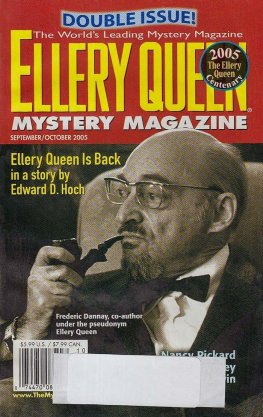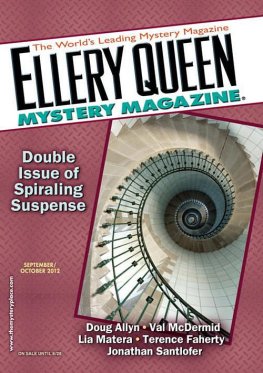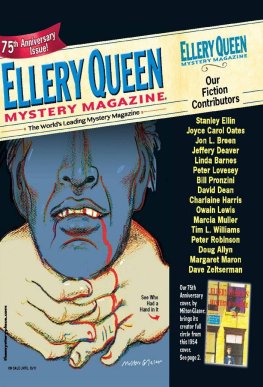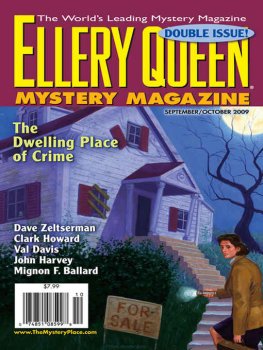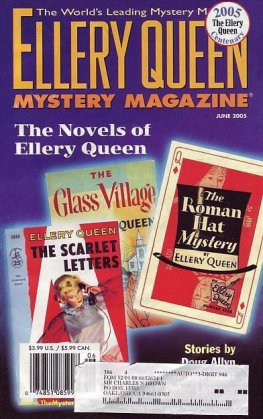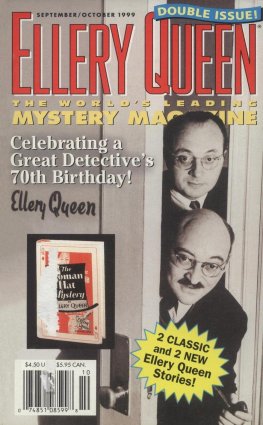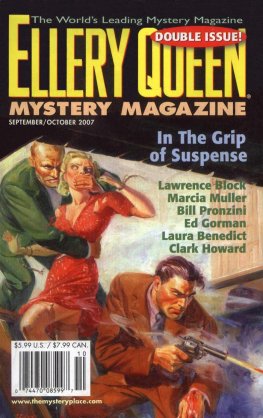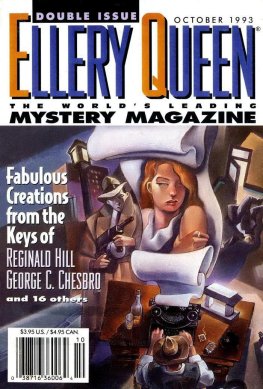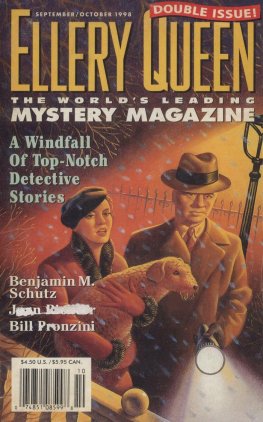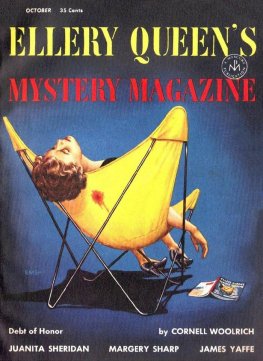Timoti Uillyamz - Ellery Queen’s Mystery Magazine. Vol. 126, No. 3 & 4. Whole No. 769 & 770, September/October 2005
Here you can read online Timoti Uillyamz - Ellery Queen’s Mystery Magazine. Vol. 126, No. 3 & 4. Whole No. 769 & 770, September/October 2005 full text of the book (entire story) in english for free. Download pdf and epub, get meaning, cover and reviews about this ebook. City: New York, year: 2005, publisher: Dell Magazines, genre: Detective and thriller. Description of the work, (preface) as well as reviews are available. Best literature library LitArk.com created for fans of good reading and offers a wide selection of genres:
Romance novel
Science fiction
Adventure
Detective
Science
History
Home and family
Prose
Art
Politics
Computer
Non-fiction
Religion
Business
Children
Humor
Choose a favorite category and find really read worthwhile books. Enjoy immersion in the world of imagination, feel the emotions of the characters or learn something new for yourself, make an fascinating discovery.
- Book:Ellery Queen’s Mystery Magazine. Vol. 126, No. 3 & 4. Whole No. 769 & 770, September/October 2005
- Author:
- Publisher:Dell Magazines
- Genre:
- Year:2005
- City:New York
- Rating:5 / 5
- Favourites:Add to favourites
- Your mark:
- 100
- 1
- 2
- 3
- 4
- 5
Ellery Queen’s Mystery Magazine. Vol. 126, No. 3 & 4. Whole No. 769 & 770, September/October 2005: summary, description and annotation
We offer to read an annotation, description, summary or preface (depends on what the author of the book "Ellery Queen’s Mystery Magazine. Vol. 126, No. 3 & 4. Whole No. 769 & 770, September/October 2005" wrote himself). If you haven't found the necessary information about the book — write in the comments, we will try to find it.
Timoti Uillyamz: author's other books
Who wrote Ellery Queen’s Mystery Magazine. Vol. 126, No. 3 & 4. Whole No. 769 & 770, September/October 2005? Find out the surname, the name of the author of the book and a list of all author's works by series.
Ellery Queen’s Mystery Magazine. Vol. 126, No. 3 & 4. Whole No. 769 & 770, September/October 2005 — read online for free the complete book (whole text) full work
Below is the text of the book, divided by pages. System saving the place of the last page read, allows you to conveniently read the book "Ellery Queen’s Mystery Magazine. Vol. 126, No. 3 & 4. Whole No. 769 & 770, September/October 2005" online for free, without having to search again every time where you left off. Put a bookmark, and you can go to the page where you finished reading at any time.
Font size:
Interval:
Bookmark:
Ellery Queens Mystery Magazine. Vol. 126, No. 3 & 4. Whole No. 769 & 770, September/October 2005
The Misadventures of Ellery Queen
by Jon L. Breen
I confess I stole the title of this piece, but it was inevitable. Ellery Queen (certainly the Frederic Dannay half and maybe the Manfred B. Lee half as well) showed his/their love of parodies and pastiches by editing a whole volume of them, The Misadventures of Sherlock Holmes (1944), which included serious tributes such as Vincent Starretts classic The Unique Hamlet alongside comical cases for sleuths with names like Sherlaw Kombs, Holmlock Shears, Hemlock Jones, and Picklock Holes. The less-than-amused guardians of the Arthur Conan Doyle estate managed to get that Holmes anthology suppressed. Undeterred, editor Queen would publish many parodies and pastiches over the first forty years of this magazine and especially enjoyed those in which the target was Queen him/themselves. The title The Misadventures of Ellery Queen was first used on a survey article by Marvin Lachman in the August 1969 issue of The Queen Canon Bibliophile, a short-lived but significant fanzine edited by the Rev. Robert E. Washer, and later on a proposed anthology, an unrealized 1980s project of Josh Pachter.
In a parody, an authors style is imitated for comic effect. In a pastiche, the characters and backgrounds of another writer are used in serious imitation of the style. Since elements of homage and mockery often coexist, editor Queen sometimes called the stories parody-pastiches. A third category beloved of editor Queen was the indirect pastiche, in which the style and characters may be different but the source of influence is explicit.
The earliest EQ parody in EQMM kidded not Queen the author but Queen the editor. In the March 1947 issue, Baynard Kendricks takeoff on true-crime articles, The Case of the Stuttering Sextant, was introduced by Clayton Rawson (a former True Detective editor who would later be a managing editor of EQMM) in the style of a Queenian story note: Tec fans will greet this epoch-making masterpiece of murder with huzzas and dancing in the streets (white tie). EQMM fans will be tickled pink to learn the story has not previously appeared in any other language (including the Sanskrit)...
As Lachman points out, most of the early parodies in EQMM were Sherlockian in nature, and while EQ the sleuth appears as a supporting player in some of them, the first writer to do a story starring a parody Ellery was Arthur Porges. Celery Green, an American sleuth traveling in Britain, assists Inspector Dewe East in two broadly comic stories, The English Village Mystery (December 1964) and The Indian Diamond Mystery (June 1965). The detectives given name allows him to stalk off at the end of each case.
I first broke into print in this magazine in the late 60s as a parody-pastiche specialist. After buying stories in imitation of Ed McBain, Burt L. Standish, and S. S. Van Dine, Fred Dannay asked if I would like to do a Queen parody, and I responded with my fourth published story, The Lithuanian Eraser Mystery (March 1969), a theatrical dying-message puzzler about E. Larry Cune, surely one of the more strained Queenian parody names. I would return to the character twice in EQMM The Swedish Boot Mystery (November 1973) and The Adventure of the Disoriented Detective (September 1976) and once in The Queen Canon Bibliophile The Idea Man (August 1969) always ringing changes on the old dying-message ploy.
In the April 1971 Wilson Library Bulletin, David Peeles The Cataloging on the Wall finds librarian Quellery Een in his office holding his treasured first edition of the Viking Portable Mickey Spillane and interviewing candidates to replace his deceased cataloger Slinki Porter. A Challenge to the Reader is included, and a library-school graduate might indeed figure out how he decided Elsie Dinsmore was the girl for the job. Funny stuff but likely to puzzle non-librarians.
One of the cleverest send-ups of the Queen style was also one of the least widely distributed, The Persian Fez Mystery; or The Tragedy of Q from Joe R. Christophers 30-copy chapbook Queens Books Investigated; or, Queen Is in the Accounting House (1983), wherein it is revealed that Elroy Queep only in his novels... solved the cases before the police; in real life his suggestions were always wrong.
Pure pastiches of Ellery Queen have been relatively rare. The earliest may be one chapter of Marion Mainwarings 1954 novel Murder in Pastiche; or, Nine Detectives All at Sea. Despite the use of assumed names for the various great detectives traveling on the same ocean liner, Mainwarings imitations are generally straight-faced. Ellery, under the name Malory King, joins detectives based on Hercule Poirot, Sir John Appleby, Perry Mason, Roderick Alleyn, Nero Wolfe, Miss Silver, Mike Hammer, and Lord Peter Wimsey in addressing a shipboard mystery. The author is a splendid literary mimic, capturing the stylistic quirks of her various subjects. Many years later, she would apply this knack to the completion of a novel left unfinished by Edith Wharton, The Buccaneers (1993).
The stories Norma Schier wrote in imitation of famous detective-story writers were more pastiche than parody, but the names of the sleuths and the authors names attached were anagrams of the originals. The stories would be collected under the title The Anagram Detectives (1979), one of the earliest products of Otto Penzlers Mysterious Press. EQ author and character became Leyne Requel in the story Dying Message (July 1966), a clever example of the titular gambit. All the other character names are anagrams as well, leading to such unusual handles as Carson Pellicot and Porter Oattes.
Despite the assumed name given the character, Dennis M. Dubins Elroy Quinns Last Case (July 1967), written when the author was a high-school senior, is also more pastiche than parody. The ageing sleuth is asked into a case with international implications by Inspec-tor Thomas Velie, Jr. Since the name Velie is not changed and various authentic Queen titles appear as supposed Quinn titles, I wonder if it was at the request of editor Queen that Ellerys name was changed.
Francis M. Nevinss brilliant first story, Open Letter to Survivors (May 1972), begins with the following epigraph from Ellery Queens Ten Days Wonder (1948): ...there was the case of Adelina Monquieux, his remarkable solution of which cannot be revealed before 1972 by agreement with that curious ladys executors... References to unrecorded cases, so common in the Sherlock Holmes canon, are rare in the Queen writings. Though the name Ellery Queen never appears in the text itself (his own idea, says Nevins, not Fred Dannays), the identity of the author/sleuth is obvious, and the story has a stature among Queen pastiches comparable to Vincent Starretts The Unique Hamlet among Holmes pastiches.
Ellery appears more or less under his own name in Julian Symonss Great Detectives: Seven Original Investigations (1981), in which Ellery (pince-nez in place) and his father are given a distinctly old-fashioned look in Tom Adamss illustrations. Taking a Sherlockian mock-scholarly approach, Symons opines that the Ellery of all the books after Halfway House (1936) was in fact a younger brother of the original, less pretentious but also less gifted. That younger brother, Dan Queen, solves a mid-twenties mystery as related by J. J. McCue, the family friend who introduced the early Queen novels. (Fred Dannay, to whom Symons sent the manuscript, admitted to being amused but offered no further comment.)
The September/October 1999 issue of this magazine, commemorating the seventieth anniversary of The Roman Hat Mystery,
Font size:
Interval:
Bookmark:
Similar books «Ellery Queen’s Mystery Magazine. Vol. 126, No. 3 & 4. Whole No. 769 & 770, September/October 2005»
Look at similar books to Ellery Queen’s Mystery Magazine. Vol. 126, No. 3 & 4. Whole No. 769 & 770, September/October 2005. We have selected literature similar in name and meaning in the hope of providing readers with more options to find new, interesting, not yet read works.
Discussion, reviews of the book Ellery Queen’s Mystery Magazine. Vol. 126, No. 3 & 4. Whole No. 769 & 770, September/October 2005 and just readers' own opinions. Leave your comments, write what you think about the work, its meaning or the main characters. Specify what exactly you liked and what you didn't like, and why you think so.

